
Tingena armigerella is a species of moth in the family Oecophoridae. T. armigerella is endemic to New Zealand where it is found in the North Island. The larvae of this species feed on plant litter. It is parasitised by the parasitic wasp Fustiserphus intrudens.
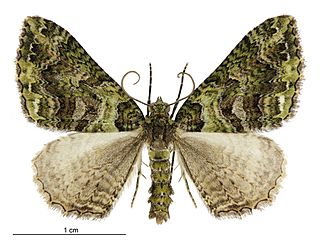
Austrocidaria similata is a species of moth of the family Geometridae. It is endemic to New Zealand and is found throughout the country including on off shore and sub Antarctic Islands. This species inhabits native forest and shrubland. Eggs are while in appearance and oval in shape and take approximately three weeks to mature. Larvae mimic the appearance of a moss covered twig and feed on Coprosma species. It has been hypothesised that this species overwinters as larvae. The larvae pupate on the ground with the pupa being enclosed in a thin cocoon made up of silk and refuse. Adults are on the wing all year but are most commonly observed from October until March. Adults are nocturnal and are attracted to light. During the day they can be observed resting on tree trunks where its forewing colouration provides camouflage protection from predators.
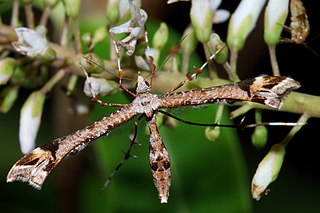
Amblyptilia falcatalis, the common Hebe plume moth, is a species of moth of the family Pterophoridae. This species was first described by Francis Walker and is endemic to New Zealand. This species can be found in both the North and South Islands. The larval host plants are in the Veronica genus and include Veronica stricta,Veronica salicifolia, Veronica elliptica, Veronica macrocarpa and Veronica speciosa. This moth likely has two broods a year and adults have been observed all year round.

Izatha attactella is a moth of the family Oecophoridae. This species is endemic to New Zealand, where it is known from both the North and South Islands as far south as mid-Canterbury. Larvae of this species feed on the soft inner surface of the bark of dead trees and shrubs. Adults have been recorded from September to December.

Heterocrossa adreptella is a moth of the Carposinidae family. This species was long considered the New Zealand raspberry budmoth however this was a taxonomic misinterpretation of the type material used to describe this species. This error was corrected in 1988 with the New Zealand raspberry budmoth giving its own species name Heterocrossa rubophaga. H. adreptella is endemic to New Zealand and has been collected in the Wellington Botanic Garden and been observed resting on mānuka branches.

Phycomorpha metachrysa, the milktree fruit moth, is a species of moth in the Copromorphidae family. It is endemic to New Zealand and has been found in the North and South Islands. The larvae feed on the fruit of species in the genus Streblus including Streblus heterophyllus. This adults of this species is on the wing from October to April.
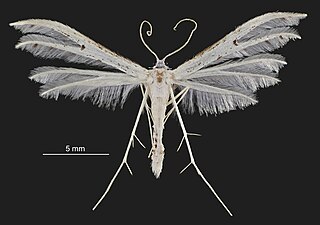
Pterophorus monospilalis, the white plume moth, is a moth of the family Pterophoridae. It is endemic to New Zealand and occurs throughout the country. It inhabits native forest, parks and domestic gardens. Larvae are active during the day, are slow moving, and feed exposed. They feed on Araliaceae species as well as on Hedera helix, Meryta sinclairii, and Schefflera digitata. There are several broods in a year. Adult moths are on the wing from November until May and are attracted to light.
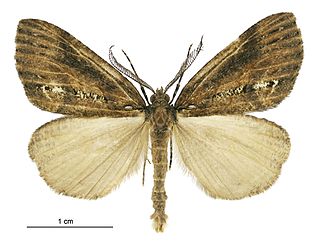
Chalastra ochrea is a moth of the family Geometridae. It is endemic to New Zealand. It has been observed in both the North and South Islands and inhabits native forest. Larvae of C. ochrea feed on the leaves of species in the genus Sophora including Sophora chathamica. Adults are on the wing from February until April. They have been collected via sugar traps.
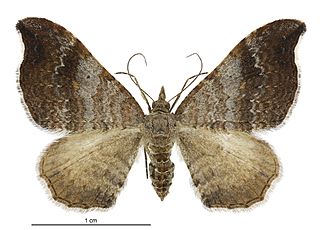
Homodotis megaspilata, also known as the small hooked-tip looper moth, is a moth of the family Geometridae. It is endemic to New Zealand and can be found throughout the country. It is regarded as being common species. The preferred habitat of this species is native forest, scrub, coastal areas and domestic gardens. Larvae feed on the dead leaves of Geniostoma ligustrifolium and likely other native plants. Once mature the larvae will pupate on the ground forming a silken cocoon protected by hiding inside two leaves of its host plant. Adults are nocturnal and are on the wing from October to April. They are attracted to light. In appearance the adults of this species are extremely variable but can be distinguished from similar species as all variations have forewings with blunt hook shaped tips.

Scoparia ustimacula, also known as the black-marked brown Scoparia moth, is a species of moth in the family Crambidae. It was described by Cajetan Felder, Rudolf Felder and Alois Friedrich Rogenhofer in 1875. It is endemic to New Zealand and can be found in the North, South and Stewart Islands. This species inhabits dense native forest at altitudes from sea level to approximately 1000 m. Although little is known of the life history of this species, larvae have been observed feeding on Hydrocotyle species. Adults are on the wing year round but are more commonly observed from September to March. Adults are nocturnal, are attracted to light and have been collected by beating scrub.

Gadira acerella is a moth in the family Crambidae. It was first described by Francis Walker. It is endemic to New Zealand and is found throughout the country. The species inhabits native forest from sea level up to subalpine altitudes. Larvae are assumed to feed on lichen or moss. Adults are on the wing from October until March, are active at night and are attracted to light. This species is distinctively patterned and coloured and is said to resemble a bird dropping at rest. The colouring also assists to camouflage the moth when it rests against lichen.

Glaucocharis auriscriptella, also known as the yellow silverling, is a moth in the family Crambidae. It was first described by Francis Walker in 1864 and is endemic to New Zealand. This species can be found in the North, South, Stewart and Great Barrier Islands. The preferred habitat of this moth is lowland and subalpine native forest as well as wetlands. The larvae feed on moss. The adult moth is day flying and is on the wing from November to February. It can be observed in colonies and can be attracted to light at night. This species likely has only one generation per year.

Thiotricha oleariae is a moth of the family Gelechiidae. It is endemic to in New Zealand, where it has been recorded from the central part of the North Island south down to Stewart Island. The species is found at altitudes of between sea-level up to 900 metres. The larvae live in a constructed case, are leaf miners and are active in November. The larval host species are within the genus Olearia. Adults are nocturnal and on the wing from November to March.
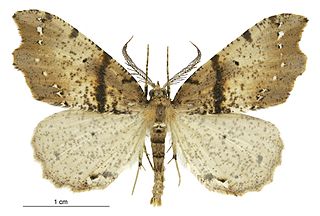
Chalastra pellurgata, also known as the brown fern moth or the pale fern looper, is a moth of the family Geometridae. This species was first described by Francis Walker in 1862. It is endemic to New Zealand and can be found throughout the country. It inhabits native forest. This species is extremely variable both in its larval and adult life stage. Larvae of this species are active during spring and summer. They feed on the fronds of fern species. C. pellurgata pupates by forming a thin cocoon on the soil amongst leaf litter and moss. Adults are on the wing throughout the year but are most common from September to March. During the day adult moths can be observed resting on dead fern fronds. They become active from dusk and are attracted to light.

Opsitycha squalidella is a moth of the family Oecophoridae. It was described by Edward Meyrick in 1884. This species is native to Australia and is likely adventive to New Zealand.
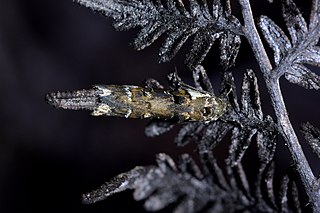
Trachypepla conspicuella is a species of moth in the family Oecophoridae. It is endemic to New Zealand and is found in both the North and South Islands. It is similar in appearance to its close relative T. euryleucota but tends to be paler. Its colouration imitates bird droppings. Larvae feed on leaf litter. Adults of this species are on the wing from November to February and have been observed resting on fences and walls.

Trachypepla contritella, the Kiwi Enigma, is a species of moth in the family Oecophoridae. Originally endemic to New Zealand this species can be found throughout that country. However, from 2012 this species has been also been recorded in the United Kingdom. The preferred habitat of T. conritella is New Zealand native forest and larvae of this species are litter leaf feeders. Adults are on the wing from November to February in New Zealand and are attracted to light.

Helastia semisignata is a moth of the family Geometridae. This species is endemic to New Zealand and is only found in the North Island. The life history of this species is in need of further investigation as sources differ about what plants host the larvae. Adults are on the wing commonly from October until March.
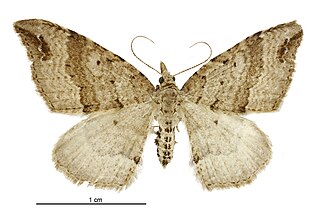
Homodotis falcata is a moth of the family Geometridae. It is endemic to New Zealand and is found in the southern part of the South Island. The larvae of this species feed on leaf litter and adults are on the wing for most months of the year. The forewings of this species can vary in depth of colour.

Atomotricha chloronota is a moth in the family Oecophoridae first described by Edward Meyrick in 1914. It is endemic to New Zealand and is found in the eastern side of the South Island and at the Antipodes Islands. It inhabits clearings with native tussocks and ferns. The larvae feed on leaf litter from silk tunnels in soil. The male adults of this species are on the wing from July to September and have been trapped via sugar traps and are attracted to light. The female of this species is brachypterous.























